Experimental Study on Deformation Monitoring of Bored Pile Based on BOTDR
Abstract
:Featured Application
Abstract
1. Introduction
2. Principle of BOTDR
- —the amount of change in Brillouin frequency shift.
- —the Brillouin frequency shift corresponding to the ambient temperature T and the strain ε.
- —the Brillouin frequency shift corresponding to the initial temperature T0 and the strain is 0.
- CT—the temperature coefficient, .
- —the strain coefficient, .
- T0—the initial temperature.
- —the actual amount strain of the optical fiber.
- —the initial strain of the optical fiber.
- —frequency shift of fiber when the strain is ;
- —the ambient temperature around the optical fiber under the same condition, the corresponding Brillouin frequency shift amount when the optical fiber strain is 0.
3. Bored Pile Field Test
3.1. Engineering and Geological Conditions
3.2. Monitoring the Deformation of Pile
- Optical fiber selection. There are two kinds of optical fiber to choose from: single-mode optical fiber and GFRP optical fiber. Although the single-mode optical fiber has the best coordination effect with the measured object’s deformation, it is easy to be wound and broken. The GFRP optical fiber is not only good in coordination with deformation of the measured object, but also not easy to damage and easy to layout. It can be seen that the single-mode optical fiber is relatively fragile, with poor internal protection effect and easy to damage. Since it is difficult to arrange it into the measured object, it is not suitable for field application practice. It can only be used for scientific research and surface monitoring of some simple structures without too many protective measures. Designated paste can be well bonded GFRP fiber by reinforcing cage in piles in the main steel profiles, through the prestress can well reflect the deformation of the pile body; its reinforcement structure can have a very good protection effect on the fiber core, and it can greatly improve the optical fiber tensile, bending, bending capacity. The fiber at the joint of bored piles and pile head is not easily damaged, and the convenience of fiber has great applicability in engineering practice. Therefore, GFRP fiber was used for monitoring in this test.
- Optical fiber layout. Figure 1 is the schematic diagram of optical fiber and field test. Glass fiber reinforced plastic (GFRP) optical fiber can be seen from Figure 1(a). The layout of optical fiber is shown in Figure 1(b). The main parameters of the optical time domain strain measuring instrument are that: Optical fiber type is GFRP, Maximum dynamic range is 15 dB, Strain distance resolution is 1 m. Strain measurement accuracy is ±50 με; strain test range is −15,000~+15,000 με. The test range is 1 km, and maximum sampling resolution is 0.05 m.
- For the laying of optical fiber sensor, the symmetrical U-shaped layout is fixed, and the optical fiber sensor can be laid on the main reinforcement of the steel cage before the optical fiber can be connected to the bored pile through concrete pouring. The steel cages are lowered and welded in turn.
- Loading and monitoring. After 30 days, the top of the pile is subjected to the loading stages, the loading and unloading conditions are shown in Table 2, including 1094 kN, 1641 kN, 2188 kN, which are selected as processing objects.
4. Results
4.1. Raw Data
4.2. Data Denoising
4.3. Data Smoothing
4.3.1. Smoothing
4.3.2. Comparison of Smoothing Methods
4.4. Data Processing Results
5. Conclusions
- (1).
- The field loading test is carried out. The BOTDR distributed optical fiber sensing technology is used to monitor the deformation of pile, and the strain of the pile is obtained to provide a basis of data for studying the deformation characteristics of bored pile. It shows the advantages of distributed optical fiber sensing technology in the deformation of pile monitoring.
- (2).
- The wavelet function is chosen to decompose the strain monitoring data of the pile. The Stein based unbiased risk threshold rigrsure processing method is used to process the signal and obtain the denoised signal. The ideal result is obtained.
- (3).
- Using the translation mean method, the Savitzky-Goiay method, percentile-filter method and Stein’s unbiased risk threshold Rigrsure processing method, the optical fiber data is processed. By comparing the smoothing results, the percentile-filter method cannot well reflect the change trend of the deformation of bored pile in large fluctuations, the overall smoothing effect of the Savitzky-Goiay method is worse than that of the translation average method, and the smoothing degree of the curve after smoothing by the translation average method is higher, which can effectively reflect the deformation change trend of the bored pile.
Author Contributions
Funding
Conflicts of Interest
References
- Gao, L.; Gong, Y.H.; Liu, H.L.; Ji, B.Q.; Xuan, Y.N.; Ma, Y. Experiment and Numerical Study on Deformation Measurement of Cast-in-Place Concrete Large-Diameter Pipe Pile Using Optical Frequency Domain Reflectometer Technology. Appl. Sci. 2018, 8, 1450. [Google Scholar] [CrossRef]
- Barrias, A.; Casas, J.R.; Villalba, S. A Review of Distributed Optical Fiber Sensors for Civil Engineering Applications. Sensors 2016, 16, 748. [Google Scholar] [CrossRef] [PubMed]
- Zhu, H.H.; Shi, B.; Zhang, C.C. FBG-based monitoring of geohazards: Current status and trends. Sensors 2017, 17, 452. [Google Scholar] [CrossRef] [PubMed]
- Byoungho, L. Review of the present status of optical fiber sensors. Opt. Fiber Technol. 2003, 9, 57–79. [Google Scholar]
- Zhao, Y.; Deng, Z.Q.; Wang, Q. Fiber optic SPR sensor for liquid concentration measurement. Sens. Actuators B Chem. 2014, 192, 229–233. [Google Scholar] [CrossRef]
- Weng, Y.; Ip, E.; Pan, Z.; Wang, T. Singlend simultaneous temperature and strain sensing techniques based on Brillouin opticaltime domain reflectometry in fewmode fibers. Opt. Express 2015, 23, 9024–9039. [Google Scholar] [CrossRef] [PubMed]
- Fabien, R.; Bao, X.; Li, Y.; Yu, Q.; Yale, A.; Kalosha, V.P.; Chen, L. Signal processing technique for distributed Brillouin sensing at centimeter spatial resolution. Lightwave Technol. 2007, 25, 3610–3618. [Google Scholar]
- Lu, Y.; Shi, B.; Wei, G.Q.; Chen, S.E.; Zhang, D. Application of a distributed optical fiber sensing technique in monitoring the stress of precastpiles. Smart Mater. Struct. 2012, 11, 115011. [Google Scholar] [CrossRef]
- Sakairi, Y.; Uchiyama, H.; Li, Z.X.; Adachi, S. System for measuring temperature and strain separately by BOTDR and OTDR. Proc. SPIE 2002, 4920, 274–284. [Google Scholar]
- Horiguchi, T.; Shimizu, K.; Kurashima, T.; Tateda, M.; Koyamada, Y. Development of a Distributed Sensing Technique Using Brillouin Scattering. J. Lightwave Technol. 1995, 13, 1296–1302. [Google Scholar] [CrossRef]
- Hong, C.Y.; Zhang, Y.F.; Li, G.W.; Zhang, M.X.; Liu, Z.X. Recent progress of using Brillouin distributed fiber optic sensors for geotechnical health monitoring. Sens. Actuators A Phys. 2017, 258, 131–145. [Google Scholar] [CrossRef]
- Kee, H.H.; Lees, G.P.; Newson, T.P. All-fiber system for simultaneous interrogation of distributed strain and temperature sensing by spontaneous Brillouin scattering. Opt. Lett. 2000, 25, 695–697. [Google Scholar] [CrossRef]
- Klar, A.; Dromy, I.; Linker, R. Monitoring tunneling induced ground displacements using distributed fiber-optic sensing. Tunn. Undergr. Space Technol. 2014, 40, 141–150. [Google Scholar] [CrossRef]
- Monsberger, C.; Woschitz, H.; Hayden, M. Deformation measurement of a driven pile using distributed fibre-optic sensing. J. Appl. Geod. 2016, 10, 61–69. [Google Scholar] [CrossRef]
- Klar, A.; Uchida, S.; Levenberg, E. In Situ Profiling of Soil Stiffness Parameters Using High-Resolution Fiber-Optic Distributed Sensing. J. Geotech. Geoenviron. Eng. 2016, 142, 04016032. [Google Scholar] [CrossRef]
- Simpson, B.; Hoult, N.A.; Moore, I.D. Distributed sensing of circumferential strain using fiber optics during full-scale buried pipe experiments. J. Pipeline Syst. Eng. Pract. 2015, 6, 04015002. [Google Scholar] [CrossRef]
- Zhu, H.-H.; Shi, B.; Yan, J.F.; Zhang, J.; Wang, J. Investigation of the evolutionary process of a reinforced model slope using a fiber-optic monitoring network. Eng. Geol. 2015, 186, 34–43. [Google Scholar] [CrossRef]
- Shangguan, M.; Wang, C.; Xia, H.; Shentu, G.; Dou, X.; Zhang, Q.; Pan, J.W. Brillouin optical time domain reflectometry for fast detection of dynamic strain incorporating double-edge technique. Opt. Commun. 2016, 398, 95–100. [Google Scholar] [CrossRef]
- Villalban, S.; Casas, J.R. Application of optical fiber distributed sensing to health monitoring of concrete structures. Mech. Syst. Signal Process. 2013, 39, 441–451. [Google Scholar] [CrossRef]
- Sierra-Pérez, J.; Torres-Arredondo, M.A.; Güemes, A. Damage and nonlinearities detection in wind turbine blades basedon strain field pattern recognition. FBGs, OBR and strain gauges comparison. Compos. Struct. 2016, 135, 156–166. [Google Scholar]
- Zhang, C.-C.; Zhu, H.-H.; Liu, S.P.; Shi, B.; Zhang, D. A kinematic method for calculating shear displacements of landslides using distributed fiber optic strain measurements. Eng. Geol. 2018, 234, 83–96. [Google Scholar] [CrossRef]
- Valencia, D.; Orejuela, D.; Salazar, J.; Valencia, J. Comparison analysis between rigrsure, sqtwolog, heursure and minimaxi techniques using hard and soft thresholding methods. In Proceedings of the 2016 XXI Symposium on Signal Processing, Images and Artificial Vision (STSIVA) IEEE, Bucaramanga, Colombia, 31 August–2 September 2016. [Google Scholar]
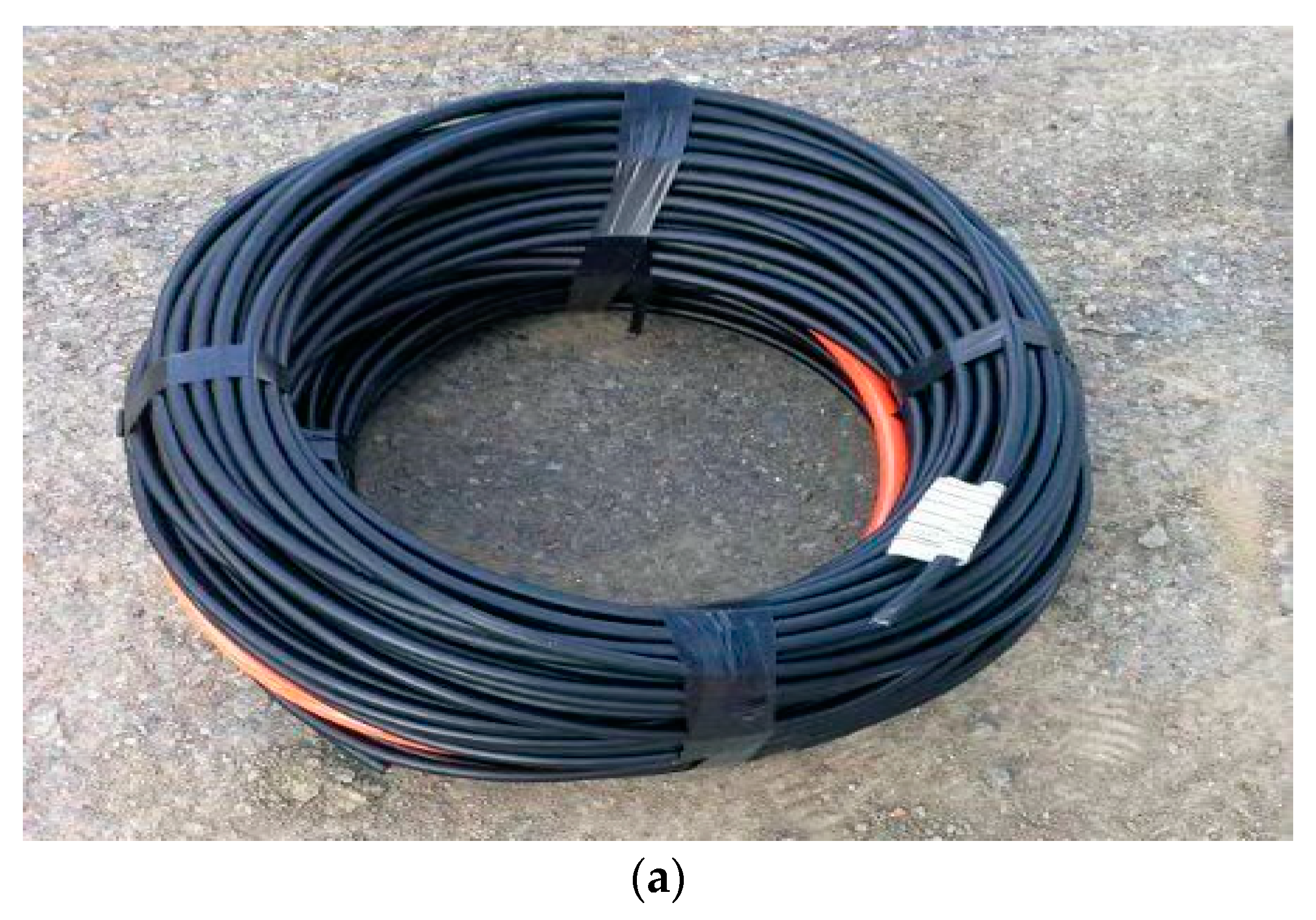
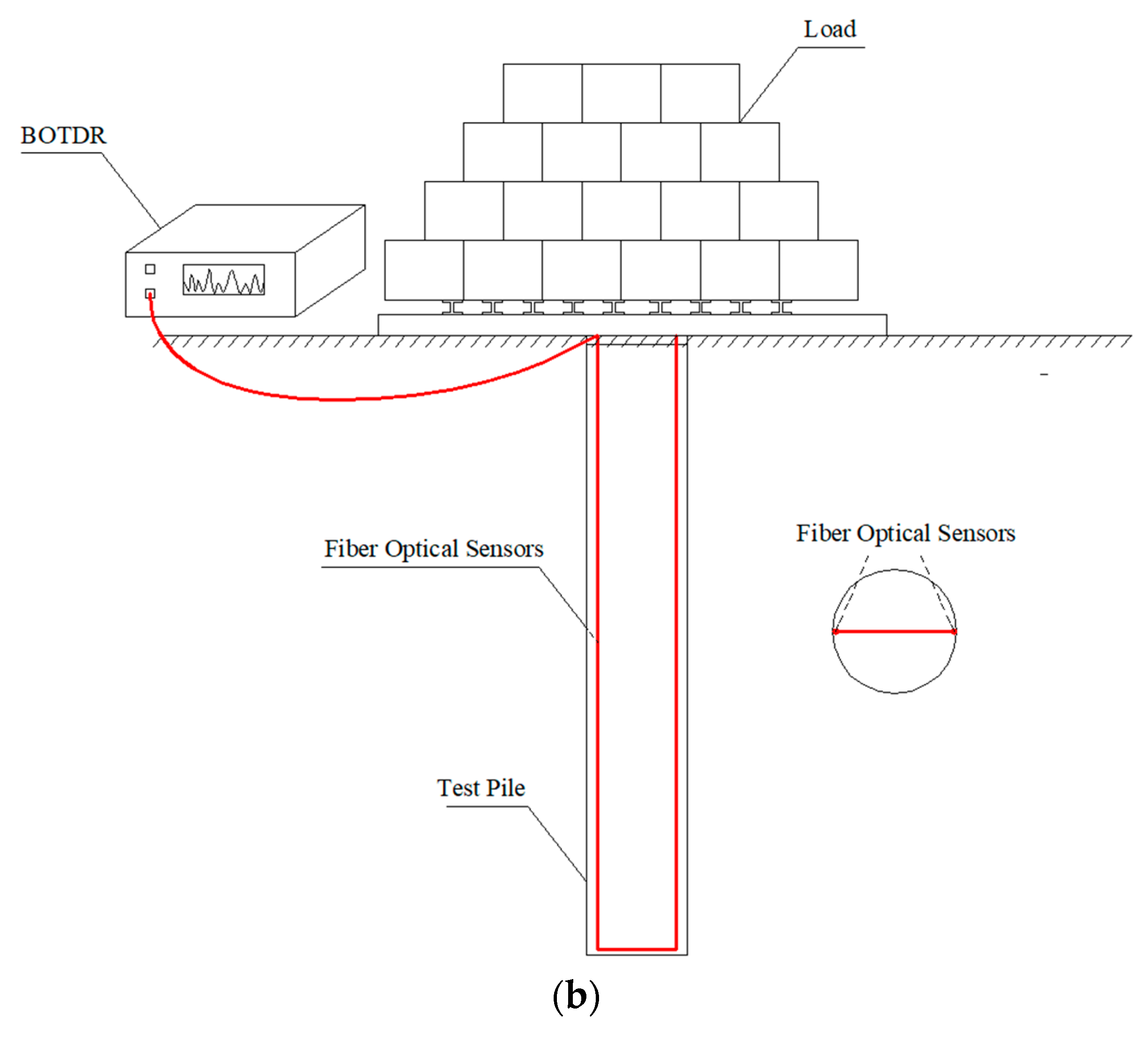
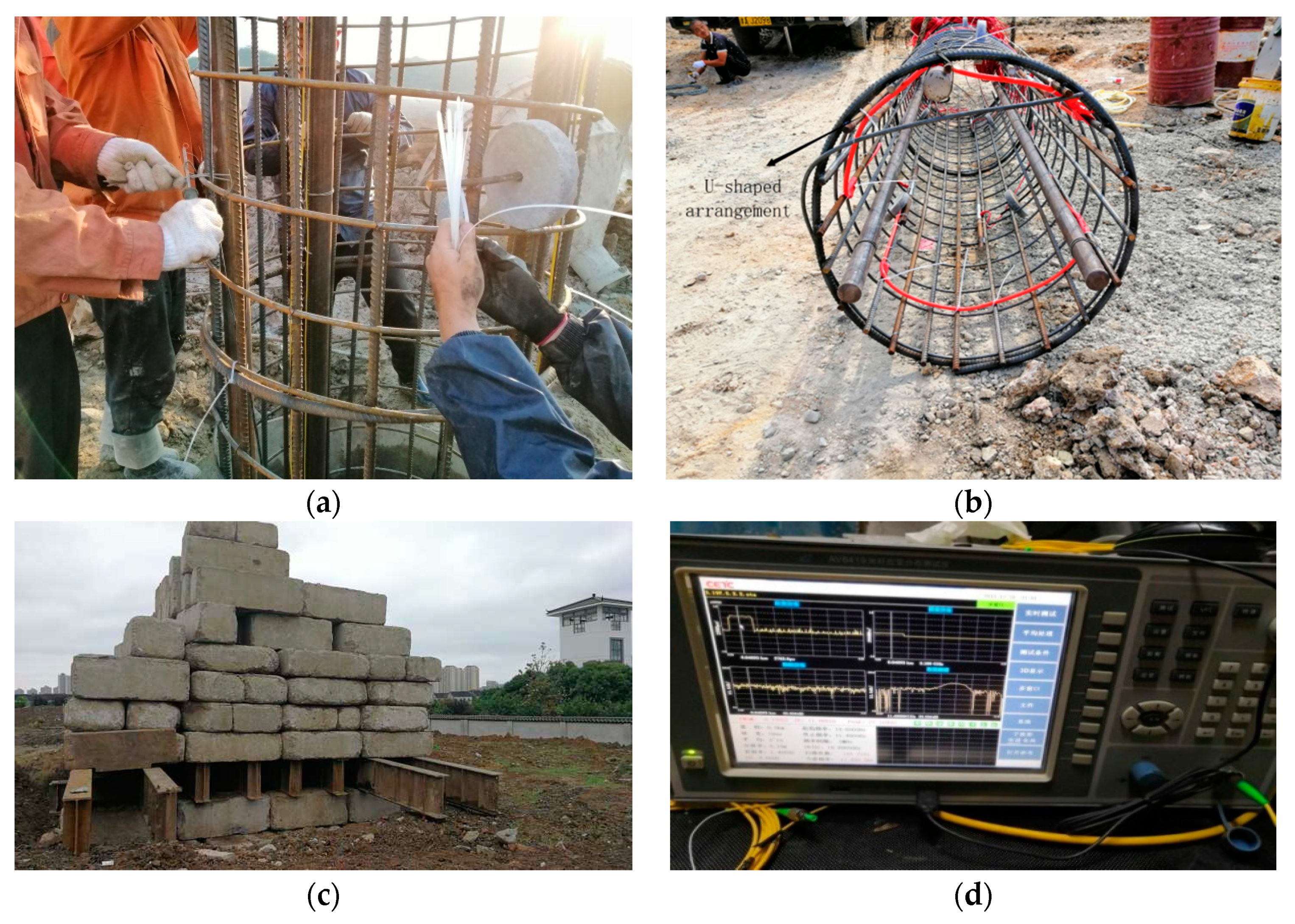
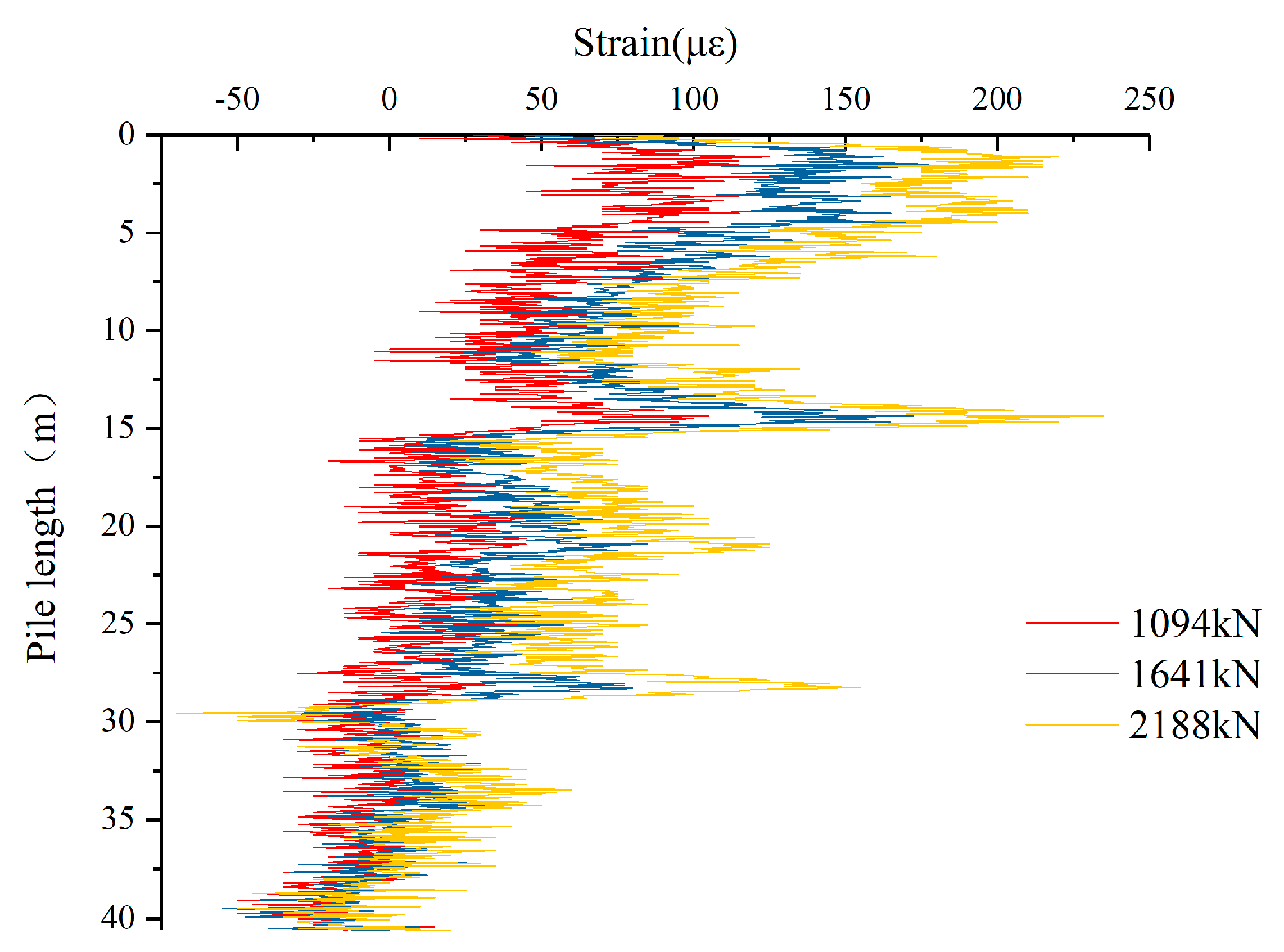
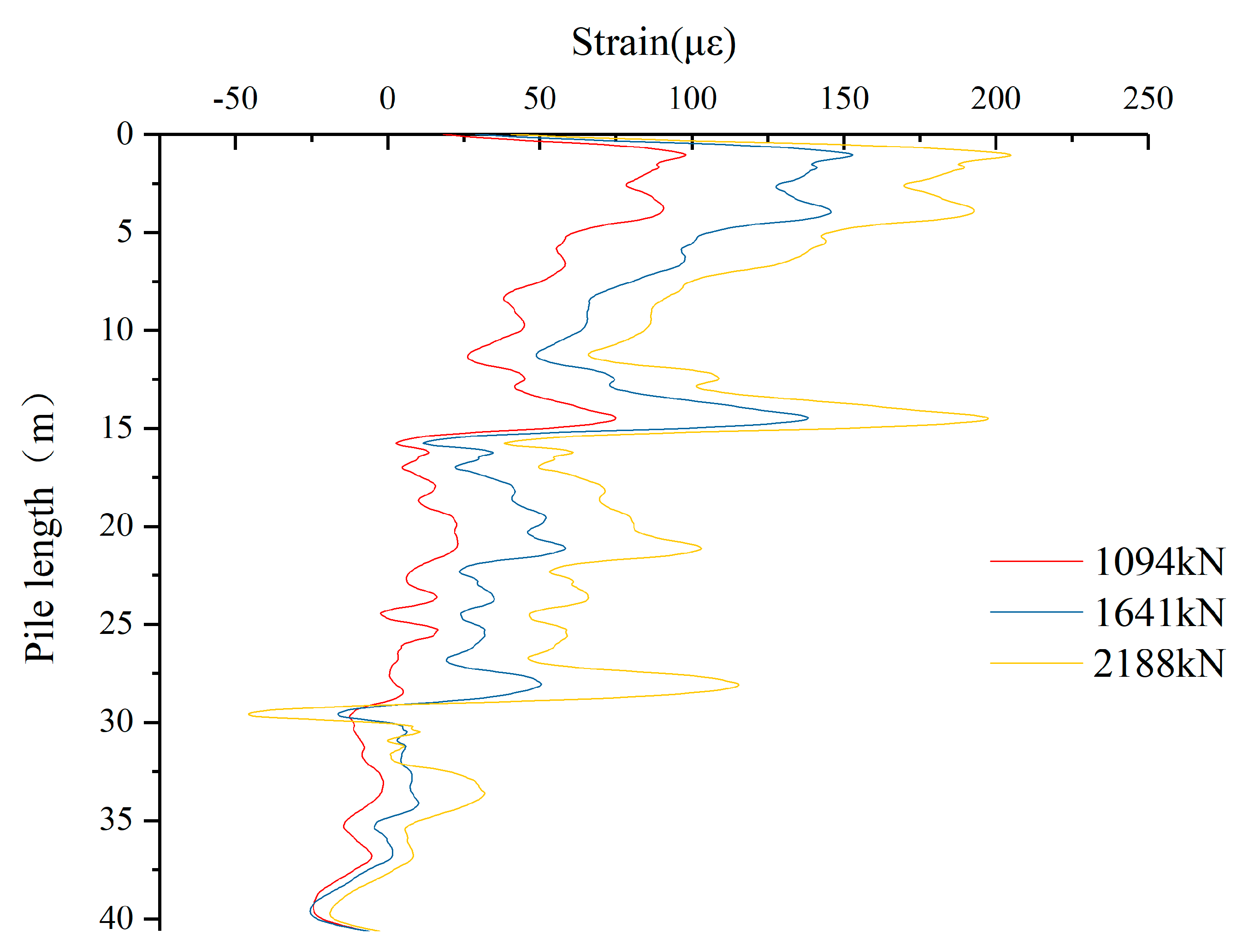
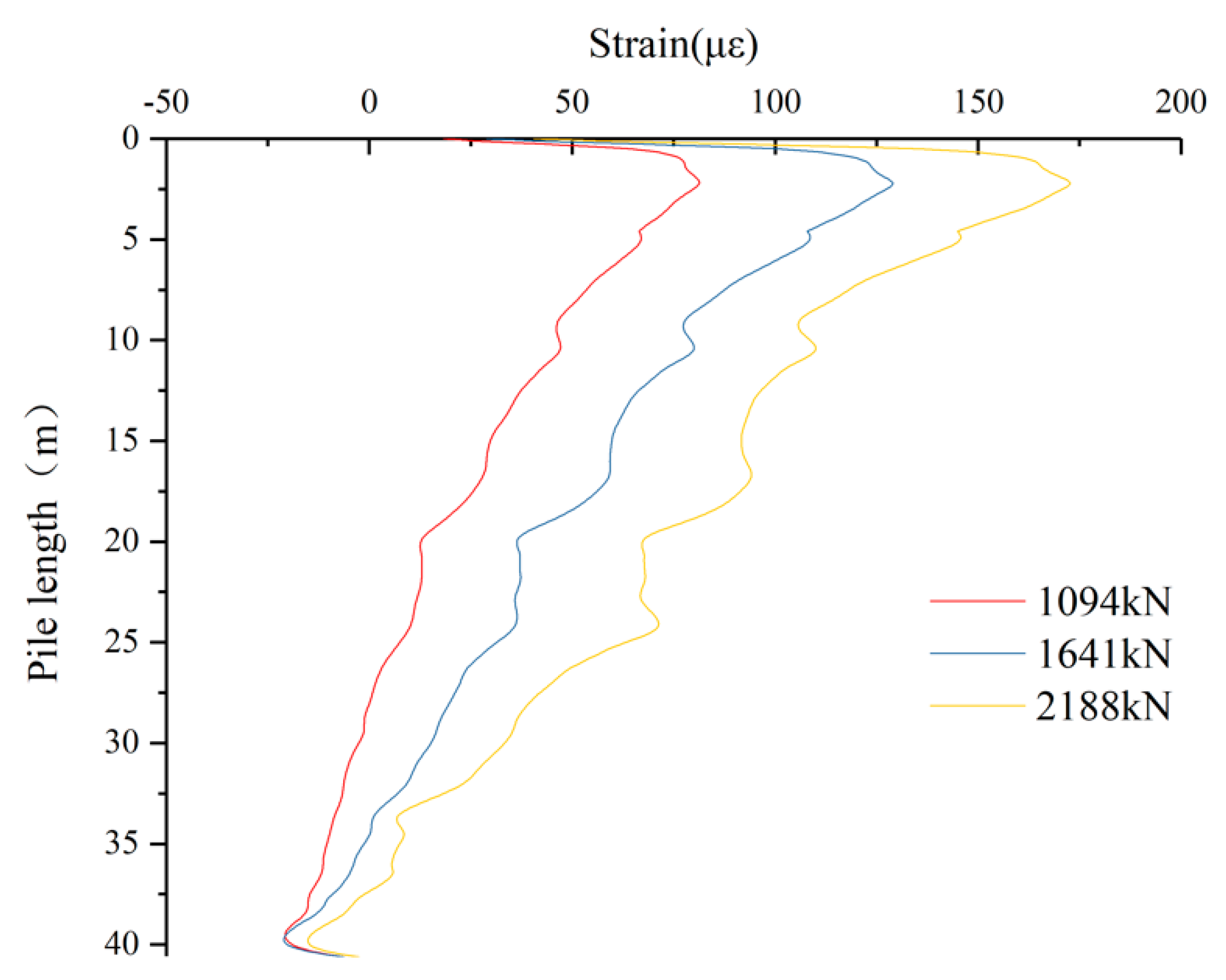
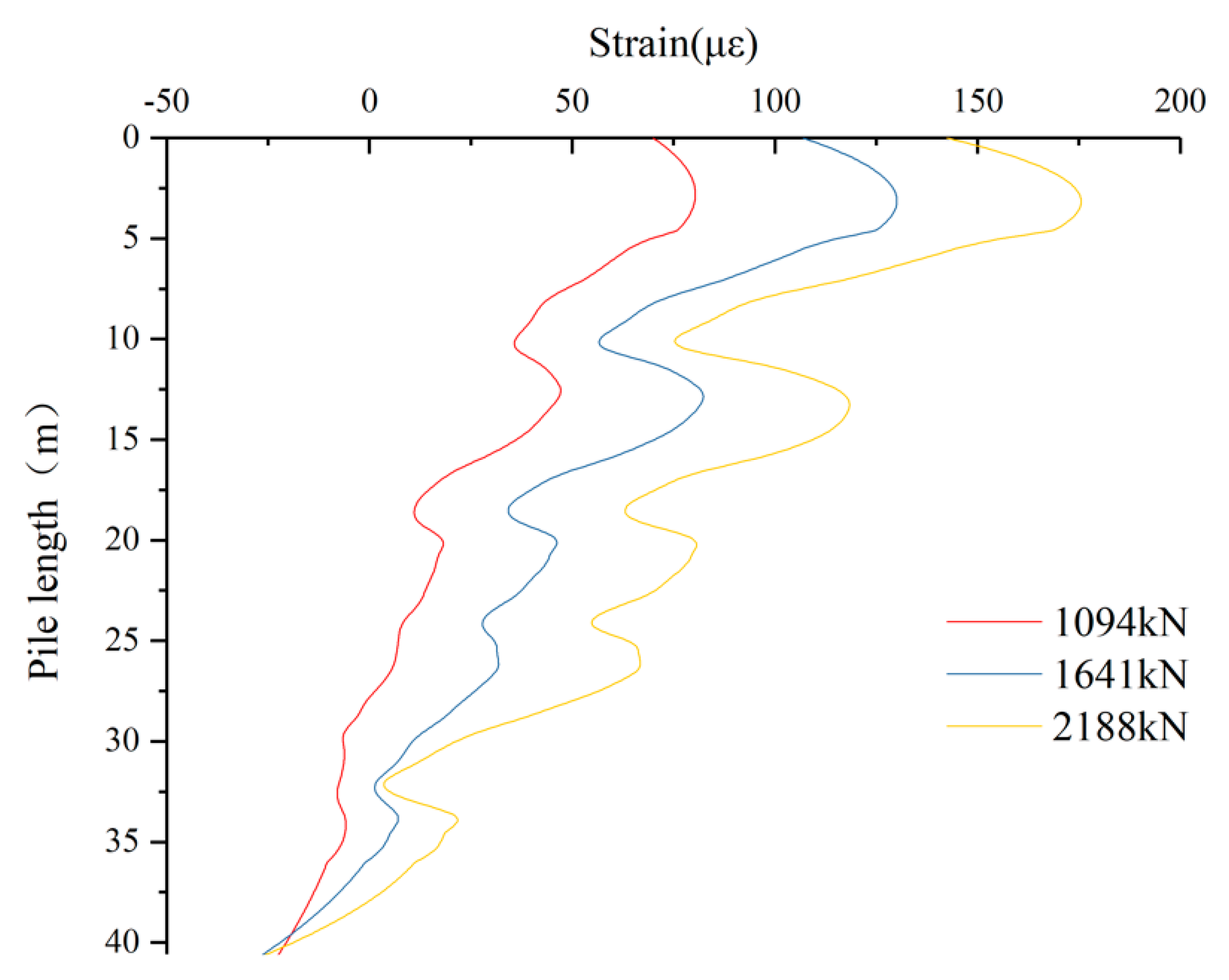
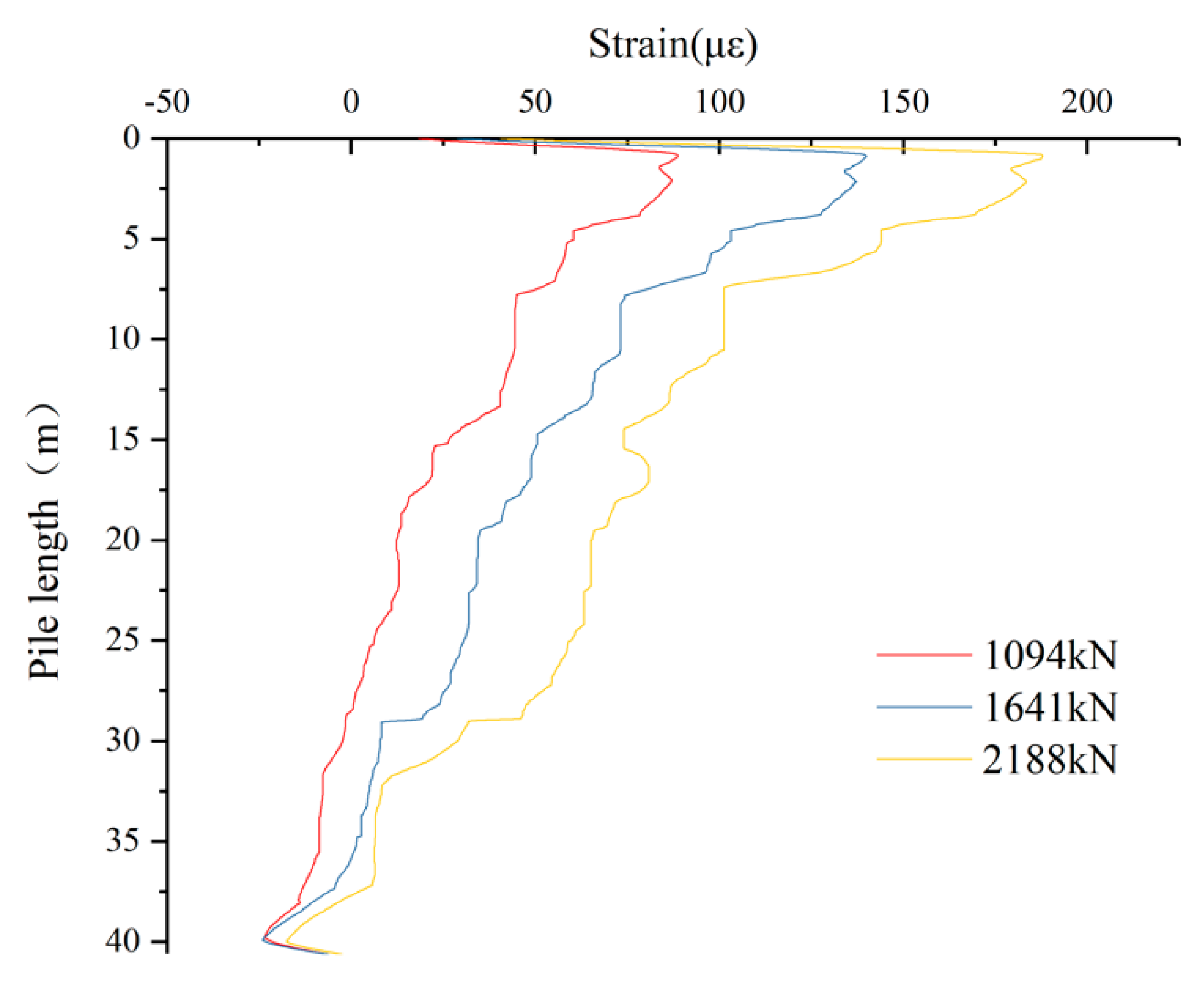
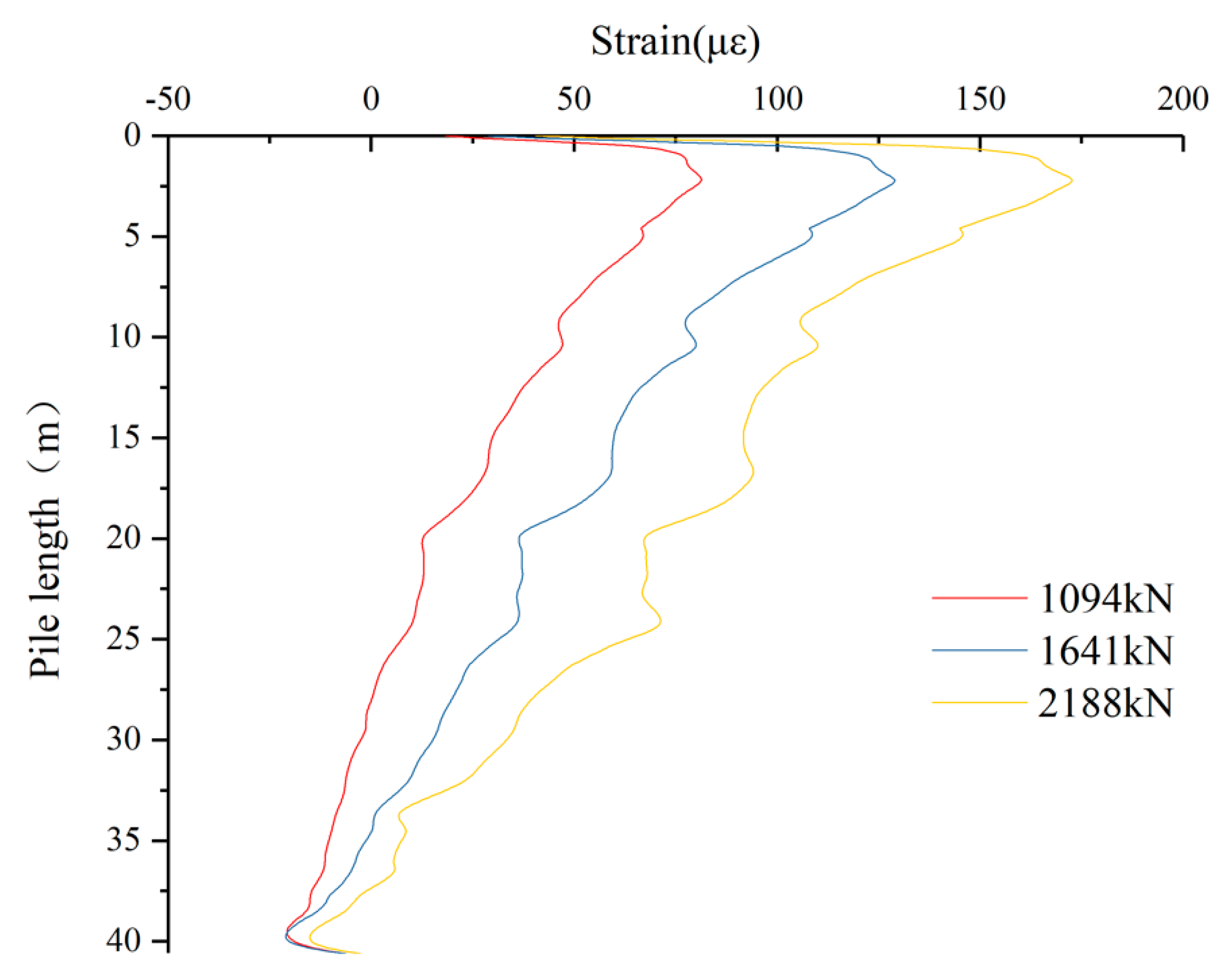
| Soil Layer Numbering | Soil Name | Thickness (m) | Density ρ (g/cm3) | Elastic Modulus E (MPa) | Cohesion C (kPa) | Internal Friction Angle φ (°) |
|---|---|---|---|---|---|---|
| (1) | Plain fill | 3.55 | 1.90 | 18.5 | 30.9 | 24.6 |
| (2) | Clay | 2.58 | 1.97 | 38.5 | 46.6 | 16.6 |
| (3) | Silty clay | 2.89 | 1.89 | 29.5 | 31.1 | 21.6 |
| (4) | Silt | 3.45 | 1.88 | 41.0 | 6.2 | 26.8 |
| (5) | Silty sand | 4.91 | 1.93 | 43.0 | 3.8 | 29.4 |
| (6) | Silty clay | 6.44 | 1.89 | 23.0 | 30.9 | 20.4 |
| (7)-1 | Silty clay | 3.08 | 1.88 | 21.5 | 30 | 19.7 |
| (7)-2 | Silty clay and silt interbed | 3.55 | 1.91 | 41.0 | 3.9 | 28.2 |
| (8) | Silty sand | — | 1.93 | 42.0 | 3.8 | 29.4 |
| Level | 0 | 1 | 2 | 3 | 4 | 5 | 6 | 7 | 8 | 9 |
|---|---|---|---|---|---|---|---|---|---|---|
| Loading grading (kN) | 0 | 1094 | 1641 | 2188 | 2735 | 3282 | 3829 | 4376 | 4923 | 5470 |
| Unloading grading (kN) | 4376 | 3288 | 2188 | 1094 | 0 |
© 2019 by the authors. Licensee MDPI, Basel, Switzerland. This article is an open access article distributed under the terms and conditions of the Creative Commons Attribution (CC BY) license (http://creativecommons.org/licenses/by/4.0/).
Share and Cite
Gao, L.; Han, C.; Xu, Z.; Jin, Y.; Yan, J. Experimental Study on Deformation Monitoring of Bored Pile Based on BOTDR. Appl. Sci. 2019, 9, 2435. https://doi.org/10.3390/app9122435
Gao L, Han C, Xu Z, Jin Y, Yan J. Experimental Study on Deformation Monitoring of Bored Pile Based on BOTDR. Applied Sciences. 2019; 9(12):2435. https://doi.org/10.3390/app9122435
Chicago/Turabian StyleGao, Lei, Chuan Han, Zhongquan Xu, Yingjie Jin, and Jianqiang Yan. 2019. "Experimental Study on Deformation Monitoring of Bored Pile Based on BOTDR" Applied Sciences 9, no. 12: 2435. https://doi.org/10.3390/app9122435
APA StyleGao, L., Han, C., Xu, Z., Jin, Y., & Yan, J. (2019). Experimental Study on Deformation Monitoring of Bored Pile Based on BOTDR. Applied Sciences, 9(12), 2435. https://doi.org/10.3390/app9122435




